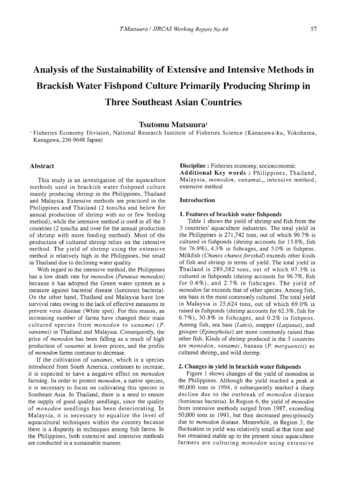Low-cost feed for Penaeus monodon reared in tanks and under semi-intensive and intensive conditions in brackishwater ponds
- Global styles
- MLA
- Vancouver
- Elsevier - Harvard
- APA
- Help

ดู/
วันที่
1997Page views
2,880ASFA keyword
AGROVOC keyword
Taxonomic term
เมตาดาต้า
แสดงระเบียนรายการเต็ม
Share
นามธรรม
Experimental diets for juvenile Penaeus monodon were formulated incorporating inexpensive indigenous raw materials. Local fish meal and cowpea meal were tested as replacements for imported protein sources and the diets did not contain vitamin and mineral premixes as supplements. Their effect on shrimp growth, survival, and feed conversion ratio were assessed under laboratory conditions. Best weight gain, specific growth rate, and feed conversion ratio were obtained in the diet with 75% replacement of protein from imported fish meal with local fish meal. This diet was field-tested in brackishwater ponds at three stocking densities: 5, 10, and 20 shrimp m−2. Results of two experimental runs in ponds showed that shrimp growth and survival was best at the lowest stocking density (5 m−2) and poorest at the highest stocking density (20 m−2) when 3% of shrimp became soft-shelled. Net pond production for 2 crops ha−1 year−1 were 1.87, 2.58, and 3.66 t ha−1 at 5, 10, and 20 m−2 stocking density. Cost-benefit analysis revealed a net return on investment (ROI) of 133, 58, 26% and payback periods of 0.7, 1.6, 4.0 years at stocking densities of 5, 10, 20 m−2, respectively. The low-cost feed, valued at P17 (US$0.70) kg−1, can effectively support pond production of P. monodon at a stocking rate of 5–10 m−2.
การอ้างอิง
Millamena, O. M., & Triño, A. T. (1997). Low-cost feed for Penaeus monodon reared in tanks and under semi-intensive and intensive conditions in brackishwater ponds. Aquaculture , 154(1), 69-78. https://doi.org/10.1016/S0044-8486(97)00036-7
Type
ArticleISSN
0044-8486คอลเลกชัน
- Journal Articles [1258]
Related items
Showing items related by title, author, creator and subject.
-
Series: JIRCAS Working Report; No. 56
Development of farming schemes following disease occurrences in monodon shrimp farming using intensive method in three Southeast Asian countries
Matsuura, Tsutomu; de la Peña, Leobert D.; Ean, Chee Phaik; Siow, Ryon; Alias, Ahmad Husin (Japan International Research Center for Agricultural Sciences, 2007)All three countries experienced major progress in intensive shrimp farming at different ties. Intensive farming of monodon shrimp (Penaeus monodon, an indigenous species) was first launched by the Philippines, followed by ... -
Series: JIRCAS Working Report; No. 44
Analysis of the sustainability of extensive and intensive methods in brackish water fishpond culture primarily producing shrimp in three Southeast Asian countries
Matsuura, Tsutomu (Japan International Research Center for Agricultural Sciences, 2006)This study is an investigation of the aquaculture methods used in brackish water fishpond culture mainly producing shrimp in the Philippines, Thailand and Malaysia. Extensive methods are practiced in the Philippines and ... -
Nursery and grow-out operation and management of Penaeus monodon (Fabricius)
Corre, Kaylin G. (Aquaculture Department, Southeast Asian Fisheries Development Center, 1988)The results of research on nursery and grow-out rearing of prawn conducted by the SEAFDEC Aquaculture Department for over a decade are reviewed. Different rearing facilities designed to accommodate hatchery-produced prawn ...





